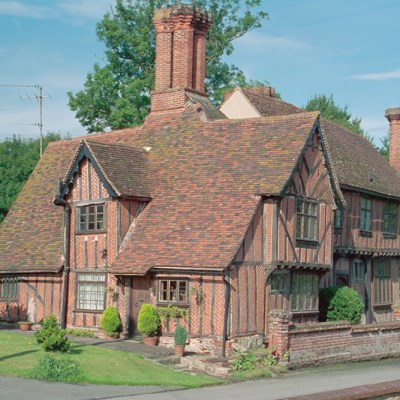From the July/August 2024 issue of Apollo. Preview and subscribe here.
In 1974 Nikolaus Pevsner published the 46th and final volume of his Buildings of England series. With Staffordshire completed, the elderly architectural historian was taking a pause from the series he described as ‘my daunting enterprise’. Each volume presented telegraphic entries, by town or village, emphasising churches, houses of significance, ancient structures and more, with short general introductions to set the wider picture. As the series evolved, the categories of building widened and the writing often became more explanatory. Pevsner insisted that the county of Staffordshire, straddling the terrain of upland and middle England, and so bridging extremes from intense industrialisation (and by then rapid deindustrialisation) to the seeming continuity of immense landed estates, should be the final one, ‘for reasons of my own’.
The Staffordshire volume, a revised edition of which has just been published, also contains ‘some words on completion of The Buildings of England’. Pevsner admitted to the tensions where ‘the historian in these evaluations changes into the critic’. Hence, the work of Denys Lasdun and James Stirling (neither of whom figure significantly in the volume) is included to test users (a term he preferred to readers) who will ‘have to take the rough with the smooth, just as I have to take the rough of Brutalism of the sixties with the smooth of the International Style of the thirties’. There are substantial omissions too. Stalwart of the Victorian Society that Pevsner was, he confessed to the thin coverage of chapels and schools. Now he found his assistants offering him ‘lists of jazzy cinemas of the twenties, lists of vernacular cottages arranged by plan types, lists of early industrial premises’. It is an admission of his own limitations, acknowledging the difficulties in judgement as each generation cedes to another.
The interior of St Joseph’s R.C. Church in Burslem, Stoke-on-Trent, designed by J.S. Brocklesby and built in 1925–27. Photo: © James O. Davies

Yet there was more to come. Revisions to most of the first editions had come thick and fast, starting in 1962. In 1983, the year of the historian’s death, the format changed – no longer could you slip a Pevsner in your pocket – and from 2002, after Yale University Press took over as publisher, the illustrations were in colour. One of the great publishing ventures of modern times shifted gear. The new style and emphasis reflected its widening pool of revising authors but Pevsner’s editorial voice could always be heard on the page.
The Staffordshire volume in its current form is a handsome memorial stone to an extraordinary endeavour, and to the scholarship, tenacity and wit of its originator. Sadly, in this case, it is also a testimonial to the revising author, the gentle scholar Christopher Wakeling, who died of Covid before the work was complete. The 1974 edition was dedicated to the memory of Lola, Pevsner’s sharp-eyed wife and steadfast driver (even, in the early days, towing an alarmingly unsteady caravan), and to Allen Lane, his equally steadfast publisher who ensured that Penguin continued its support in the face of ‘substantial losses’. This volume has different boundaries to that of its predecessor. Elsewhere in the series, the so-called Black Country is now combined with Birmingham, in a volume published in 2022. But it remains weighted heavily with places which are underestimated or little known, if not baffling. The complexities of the conurbation that is Stoke-on-Trent make it peculiarly difficult to describe compared to, say, Lichfield (the cathedral city of the county) or even the brewing centre, Burton-upon-Trent, where ‘rather than the mighty brick structures that dominated fifty years ago, banks of glinting steel silos and fermentation tanks now catch the eye.’
Christopher Wakeling is a generous revisionist. In most of the revised or jointly authored editions, you must apply your ear to the timbre of the writing or the nature of the judgements to extract Pevsner’s voice, but here Wakeling includes many short direct quotations. In addition, there are helpful, discursive introductions, of which the one for Stoke-on-Trent is among the best.
The Wedgwood Memorial Institute in Burslem, Stoke-on-Trent, designed by G.B. Nicholls, Robert Edgar and John Lockwood Kipling and built 1863–69. Photo: © James O. Davies

Local people were of only vague interest to Pevsner, who glimpsed them in the gloom of Liverpool Street station (Essex) or enjoying the new M1 motorway (Northamptonshire). In the Staffordshire volume, Wakeling speaks up for the residents of the beleaguered Six Towns of the Potteries. He points to an understandable ‘impulse to create a conventional city centre […] and the desire to work with the grain of a polycentric urban landscape. Rather like Los Angeles, the city of Stoke-on-Trent best rewards the visitor who learns something of its geography.’
Yet as in Los Angeles, visitors to Stoke-on-Trent are left reeling as they negotiate that geography, thanks to a crude 1970s road system. The city has, Wakeling explains, been formed by a combination of hill villages growing into towns and lowland centres following their lead, all of which has left little opportunity or space for conventional suburbs. Confusingly each town had its own civic centre, town hall, market hall and library, along with glories such as the former Wedgwood Memorial Institute in Burslem, opened in 1869. Burslem is the ‘mother town’ of the six and even now has a considerable potting presence.
The Chinese garden at Biddulph Grange Garden near Stoke-on-Trent, designed by James Bateman and Edward Cooke in the 1850s. Photo: courtesy the National Trust; © Martine Hamilton-Knight

Overall, the picture has darkened since Pevsner’s time. The towns have become splintered from each other, their fabric torn by crass road systems and the loss of buildings that, writes Wakeling, ‘unfairly failed to make the official list of buildings of architectural and historic importance’. In stark contrast are the luxurious designed landscapes dotted with pavilions and follies, the contrived settings of Shugborough Hall, Weston Park or Alton Towers, and the gardens of Biddulph Grange.
There is, however, only one sustainable future for the series and the now completed volumes for England, Scotland and Wales, and that future is digital. A small group of supporters are actively pursuing this prospect. Should the project succeed, subscribers will benefit from corrections and updates and a GPS locator. Meanwhile, Yale University Press will continue to publish the volumes covering Ireland that remain to be revised.
From the July/August 2024 issue of Apollo. Preview and subscribe here.



